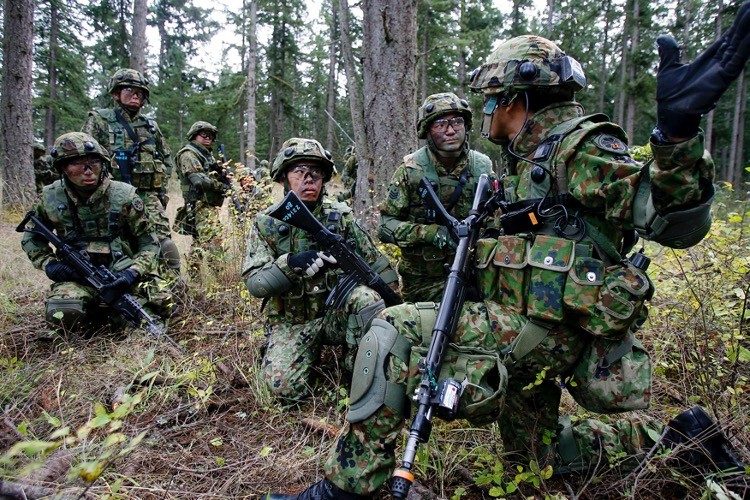
SINGAPORE — Japan is planning to expand an Okinawa-based ground force unit to protect remote southwestern islands and prepare for a Taiwan-linked military emergency in light of China’s rising bellicosity, according to a government source familiar with the matter.
The island nation’s Defense Ministry wants to raise the number of infantry regiments under the Ground Self-Defense Force’s 15th brigade to two, as well as increase its highest rank from major general to general, the source added.
The planned amendments are to be included in one of the three major security documents the government will revise later this month. These changes are supposed to successfully transform the unit into the equivalent of a division, which is greater in rank than a brigade.
The ministry is mulling over the name of the division and how many more personnel it would involve beyond the present 2,200-strong 15th Brigade.
The 15th brigade, based in Okinawa’s prefectural capital of Naha, is regarded as the vanguard to defend the Nansei Islands. These islands form a chain that includes Okinawa and stretches southwest from Kyushu toward Taiwan. The brigade’s mission includes protecting the Senkaku Islands, a group of East China Sea islets administered by Japan but claimed by China.
As the infantry regiment is to be increased in size, the ministry is also hoping to raise the number of units responsible for communications, supplies, and facility maintenance, the source said.
Moreover, certain administrative functions of the GSDF Western Army at Camp Kengun in Kumamoto Prefecture will relocate to Okinawa and assume the responsibility of liaising with local authorities to evacuate and protect civilians during an emergency.
A proposal has also been put together to relocate some of the Western Army’s support functions for missile units on remote islands to the Okinawa-based unit.
Upgrading the brigade’s highest rank to general is meant to enhance cooperation between Japan and the United States, as the title would be equivalent to commanding general of the U.S. Marine Corps’ Third Marine Expeditionary Force, also based in Okinawa.
While some brigade members are slated to be relocated to the GSDF Western Army during the reorganization, the envisioned expansion of the Okinawa unit will lead to an overall rise in staff.
In wake of China’s expansion activities around the Taiwan Strait and persistently sending vessels around the Senkaku Islands, Japan’s Defense Ministry has continued to beef up the Self-Defense Forces.
Furthermore, the ministry in 2016 established a coastal surveillance unit on Japan’s westernmost inhabited island of Yonaguni, located about 100 kilometers (62 miles) from Taiwan.
Japan has also deployed missile units on Miyako and Amami-Oshima islands and hopes to set up another on Ishigaki Island, near the Senkakus and Taiwan.
Taiwan’s safety has security implications for Japan. After a trip to Taipei by the U.S. House Speaker Nancy Pelosi in August, the Chinese military flexed their muscles by launching ballistic missiles, five of which entered Japan’s exclusive economic zone in the East China Sea for the first time.
Moreover, Japan’s Okinawa is a mere short flight away from Taiwan.
Cross-strait tensions have only increased following Chinese President Xi Jinping’s declaration at the twice-a-decade Communist Party Congress in October that the mainland would not exclude the prospect of using force to reunite with Taiwan, if necessary.
A senior member of Japan’s ruling Liberal Democratic Party, Koichi Hagiuda, also said on December 11 during a visit to Taiwan that it is imperative that Japan increase its military spending in wake of the threats posed by communist North Korea and China.
The visit is the first to Taiwan by a top member of Japan’s ruling party in 19 years.
While Taiwan and Japan do not have formal diplomatic ties, they have warm unofficial relations. Besides, both have shared concerns about the rising pugilism of China.
Hagiuda said that since World War II, Japan has “walked the path of peace.”
“However, just reciting the word peace is of course not enough for our peace to be protected,” he told a forum on Japan-Taiwan relations.
As Japan prepares its 2023 budget, Prime Minister Fumio Kishida has already announced plans to raise defense spending to an amount equivalent to two percent of gross domestic product within five years, from the current one percent.
Kishida’s decision would bring Japan’s yearly defense budget to more than 11 trillion yen ($80.4 billion) from 5.4 trillion yen ($39.4 billion) now, enabling the country to have the world’s third-largest military budget, after the United States and China.
Additionally, Hagiuda highlighted China’s gigantic military spending, as well as North Korean missile tests, as the factors prompting Japan to increase its defense budget.
“In the face of such a grim reality, half measures have no meaning at all.”
Japan’s defense capabilities are vital to safeguard lives and peace and must be built upon instantly, not within five years, he added.
“It’s important to show clearly that we have sufficient capacity to make any would-be aggressor think twice.”
The United States is obliged by law to offer Taiwan the resources to defend itself, though it is unclear about whether it would dispatch forces to aid Taiwan in a war with China.
In a speech to a think-tank in Taiwan last December, the late former Japanese prime minister Shinzo Abe announced that Japan and the United States could not stand by in the event of a Chinese invasion of Taiwan, and that Beijing needs to know this.
Previously, U.S. officials emphasized that the Senkakus come under Article 5 of the U.S.-Japan treaty mandating America’s defense of Japan, a Pentagon report states. One may compare the clause to the North Atlantic Treaty Organization’s Article 5 Defense clause, which obliges a collective response to any hostile attack. With its increasing presence in the Pacific, the U.S. Navy would be well poised to use Carrier Strike Groups, air assets from Guam, or even amphibious forces dispatched to protect Japan and its surroundings from any type of Chinese attack.



